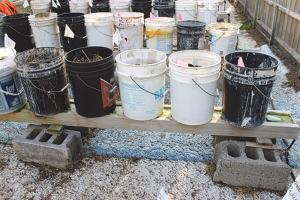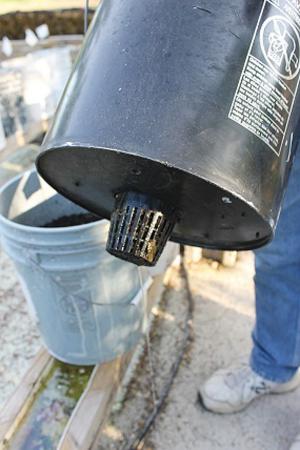2016 - Volume #40, Issue #4, Page #10
[ Sample Stories From This Issue | List of All Stories In This Issue | Print this story
| Read this issue]
Easy To Manage “Bucket Garden”
 |
 |
He cuts a 3-in. dia. hole in the bottom of each bucket, inserts a plastic net filter cup into the hole (available at aquarium stores), and then fills the bucket with soil. The net cups set inside rain gutter troughs that are reinforced on both sides with two-by-fours. Each piece of rain gutter rests on cement blocks covered by carpet and holds nine 5-gal. buckets or 11 smaller ones.
The troughs, arranged in rows, are connected with black hoses to a 250-gal. water tank. Float valves automatically gravity-feed water into the troughs whenever the water level gets low.
Hovet advises using black hoses since white ones seem to encourage algae growth and also get brittle and deteriorate in the sun. Algae can plug hoses, but he hasn’t had a problem since he switched to the black ones. He also covers the outside of the water tank with black plastic to keep out algae. Algae in the troughs, though, isn’t a problem.
This “beneath the bucket” irrigation system allows the soil to soak up water without having the bottom of the bucket standing in water. Hovet says it works really well except during extremely dry spells, when the top of the soil might dry out a little more. There’s only a little evaporation from the troughs, and no water is wasted as can happen with overhead sprinklers.
Hovet says it costs about $66 for the material and equipment for each trough set up if you buy new.
The entire system is reusable year after year. Hovet says, “We’re into our fifth summer using this system but we haven’t had to replace anything yet. So on an annual cost, we’re spending about $13. You can’t get anyone to pull weeds for $13. Also, the system is scale-able so it can be enlarged easily over time.”
About the only garden crops that Hovet doesn’t grow in buckets are corn, squash and melons. Corn takes up a lot of space. Vines growing from the top of the buckets and then draping over the rims tend to get crimped and don’t do well.
At the end of the growing season Hovet dumps the contents of all the buckets onto a tarp, then folds the tarp over to cover the pile. In the spring he shovels the soil into a cement mixer, along with a little fertilizer and water. “I fluff it up good,” he says, “and then fill the buckets up again.”
Contact: FARM SHOW Followup: Ken Hovet, Browerville, Minn. 56438 (ph 320 491-8928; hovet@wisper-wireless.com).

Click here to download page story appeared in.

Click here to read entire issue
To read the rest of this story, download this issue below or click here to register with your account number.




